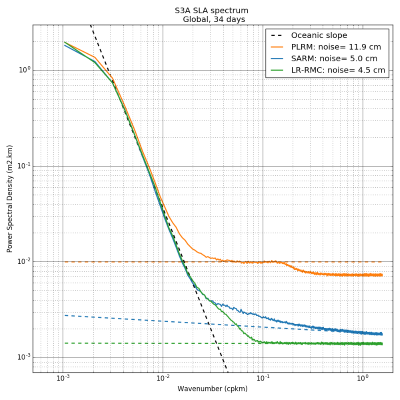Experimental Sentinel 3 products (Peachi)
Types of dataset: Mono-mission Sentinel-3A altimetry product, LR-RMC mode. These products are produced by CLS in the framework of the Peachi project, funded by CNES.
Contents: Along-track level-2 estimations at 20Hz rate in LR-RMC mode. LR-RMC associated waveforms are also included, as well with the geophysical corrections applied to the altimeter range.
Use: open ocean, coastal applications
Description: specific product generated using the innovative LR-RMC altimetry mode, more details about the processing mode below.
Users should keep in mind that these products are experimental products. Notably, they are not produced on an operational basis. They are freely distributed without any warranty of any kind.
Geographic coverage: Global coverage corresponding to Sentinel-3A spatial sampling
Format: NetCDF-CF
LR-RMC presentation
The Low-Resolution with Range Migration Correction (LR-RMC) mode is a newly ocean delay-Doppler altimetry processing, therefore applicable for CryoSat-2 & Sentinel-3 missions. The processing has been first designed and used by Thales Alenia Space for in-flight assessing of Cryosat-2 data [Phalippou et Demeestere, 2011]. It has then been revisited by Boy et al. [2017a] as one of the most promising altimeter data processing solution to deal with long ocean waves issues while keeping high delay/Doppler measurement capability in terms of precision.
The processing in a nutshell
Similarly to unfocused SAR altimetry, the LR-RMC method coherently combines radar pulses in a burst to create a set of Doppler beams. But, unlike it, the LR-RMC method then sums all the beams contained in a radar cycle (4 bursts of 64 beams for the open-burst Sentinel-3-mode altimeter) to build a 20-Hz multi-looked waveform. The resulting footprint is much larger than that of the unfocused SAR altimeter (and as large as the illuminated area in conventional altimetry) allowing a better spatial average of the surface elevation to mitigate long ocean wave effects.
The LR-RMC technic takes advantage of a number of similarities in processing with the unfocused SAR altimeter approach (as described in Boy et al. [2017b]), which made its implementation relatively straightforward. This is even made easier thank to major simplifications in the LR-RMC data processing scheme (no beam steering is needed and a shorter integration time is used to produce a mean multi-looked echo thus minimizing possible errors in alignment and echo beam stacking, but also limiting possible surface movement effects). Despite this time duration reduction, the number of beams is as high as in SAR altimeter mode processing (4x64 averaged beams compared to 256 averaged looks in SAR altimetry), thus providing a noise reduction at least as good as, or even better than in SAR mode.
LR-RMC benefits over open-ocean
The two years’ time series of Sentinel-3A LR-RMC data provided by AVISO have been deeply analyzed by CNES/CLS. The processing shows promising results in many aspects:
- LR-RMC improves the measurement precision (SSH & SWH) compared to unfocused SAR-mode over ocean. Noise reduction is about 20% in average at 2.7m wave height
- LR-RMC provides no-correlated errors as observed in LRM data, and makes some improvements in the detection of meso-scale structures compared to unfocused SAR-mode
- LR-RMC brings stable performances whatever swell condition while unfocused SAR-mode is largely negatively impact
A presentation of the processing, from Boy et al. [2017a], at Miami OSTST 2017, is available here
References
- Phalippou, L., and F. Demeestere: Optimal retracking of SAR altimeter echoes over open ocean : Theory versus results for SIRAL2 data, OSTST Meeting 2011, San Diego, California, Oct. 19-21, 2011.
- Boy, F., T. Moreau, P. Thibaut, P. Rieu, J. Aublanc, N. Picot, P. Femenias, C. Mavrocordatos, “New stacking method for removing the SAR sensitivity to swell”, OSTST Meeting 2017, Miami, Florida, USA, Oct. 23-27, 2017a.
- Boy, F., Desjonquères, J-D., Picot, N., Moreau, T., and Raynal, M., “CryoSat-2 SAR Mode Over Oceans: Processing Methods, Global Assessment and Benefits”, IEEE Trans. Geosci. Remote Sens., 55, 148-158, 2017b. DOI: 10.1109/TGRS.2016.2601958
- Scientific publication coming in early 2020 by [Moreau et al., 2020]
Copyright : 2017- 2019
| to get access Aviso products and select the product "Experimental Sentinel3 products (Peachi)" |
20 Hz product
Satellite | Distribution media | Frequency | Delivery delay | Data period | Data used | File weight |
|---|---|---|---|---|---|---|
Sentinel-3A | Please refer to | 27 days | one shot | july 2016 - August 2018 | One pass per file | 36MB per pass file |





